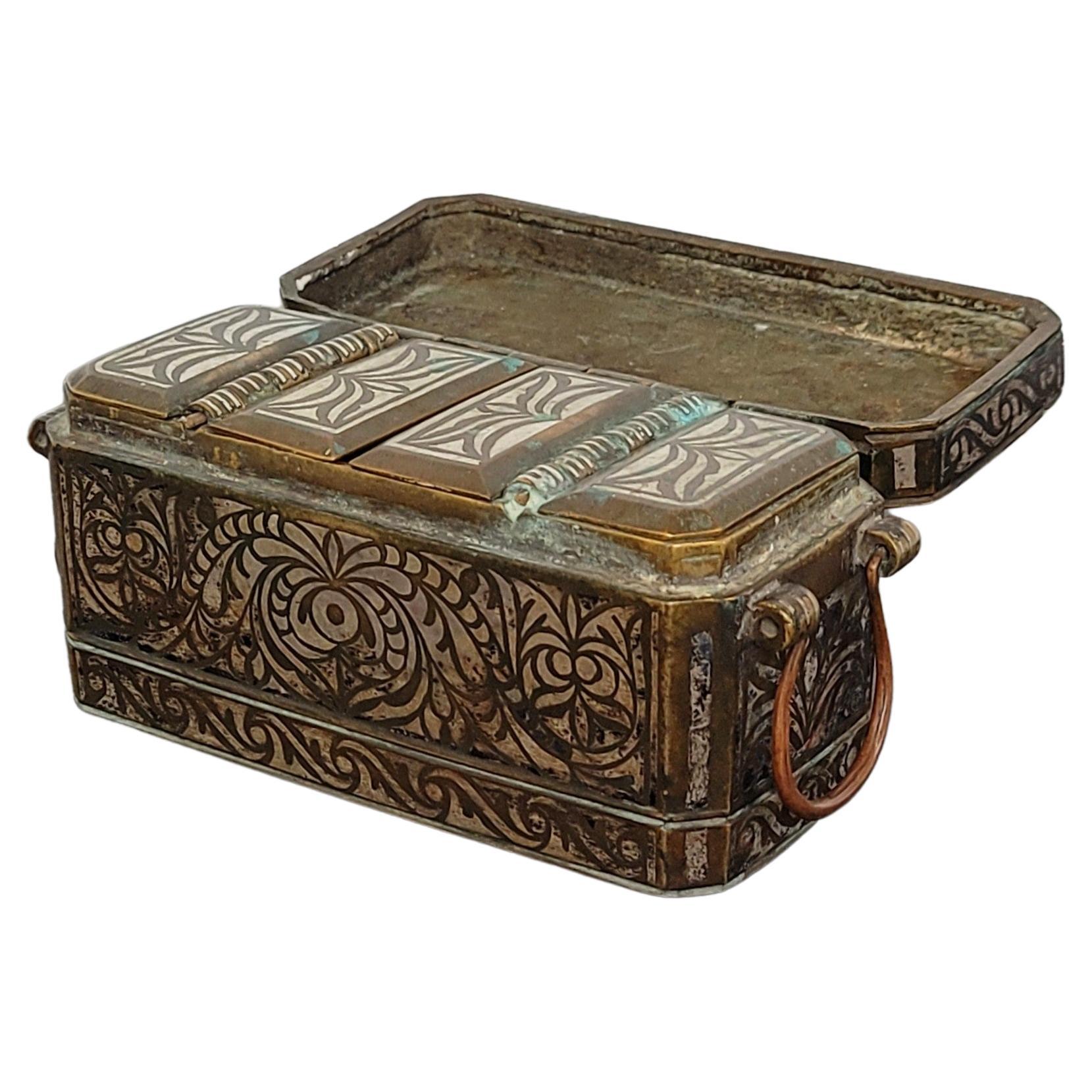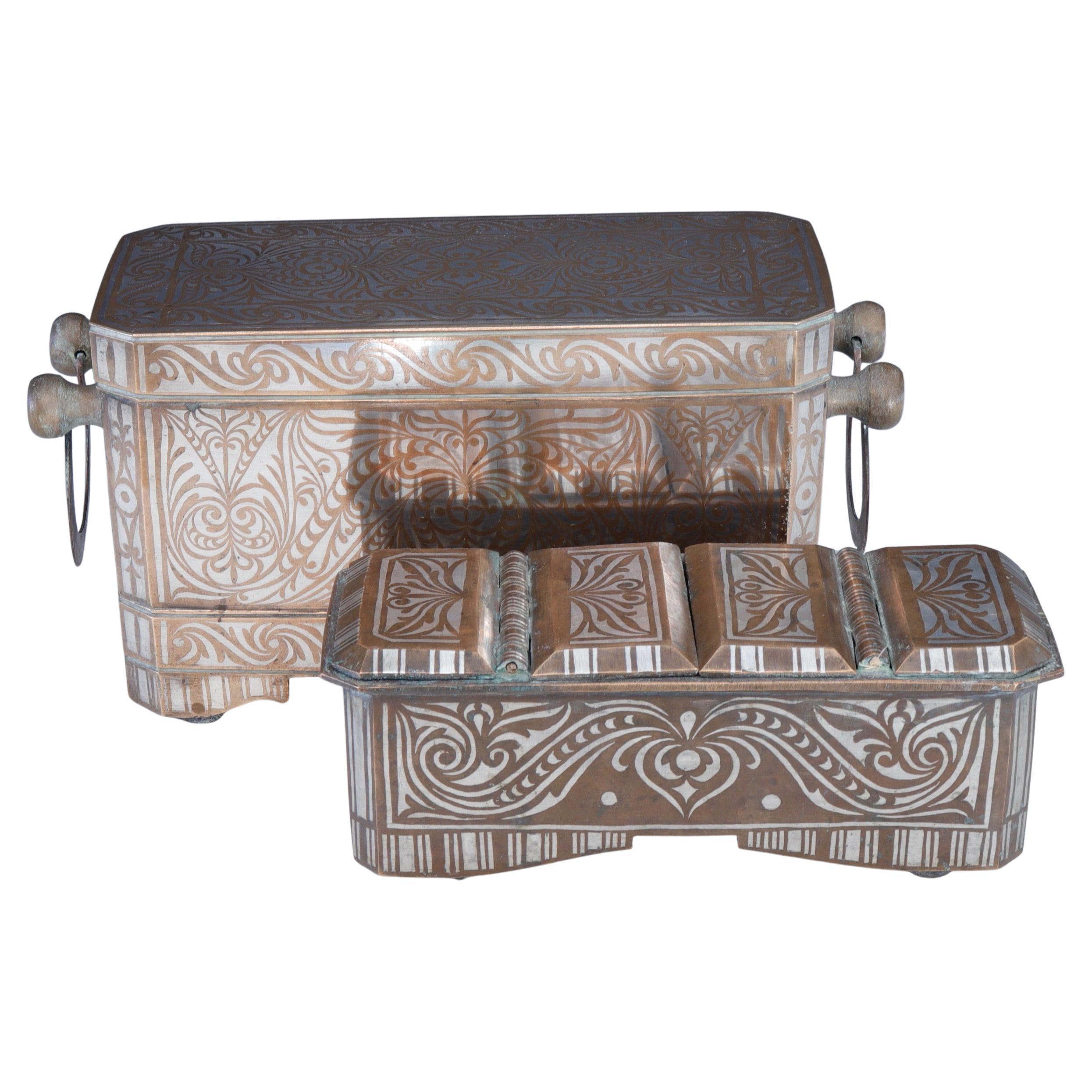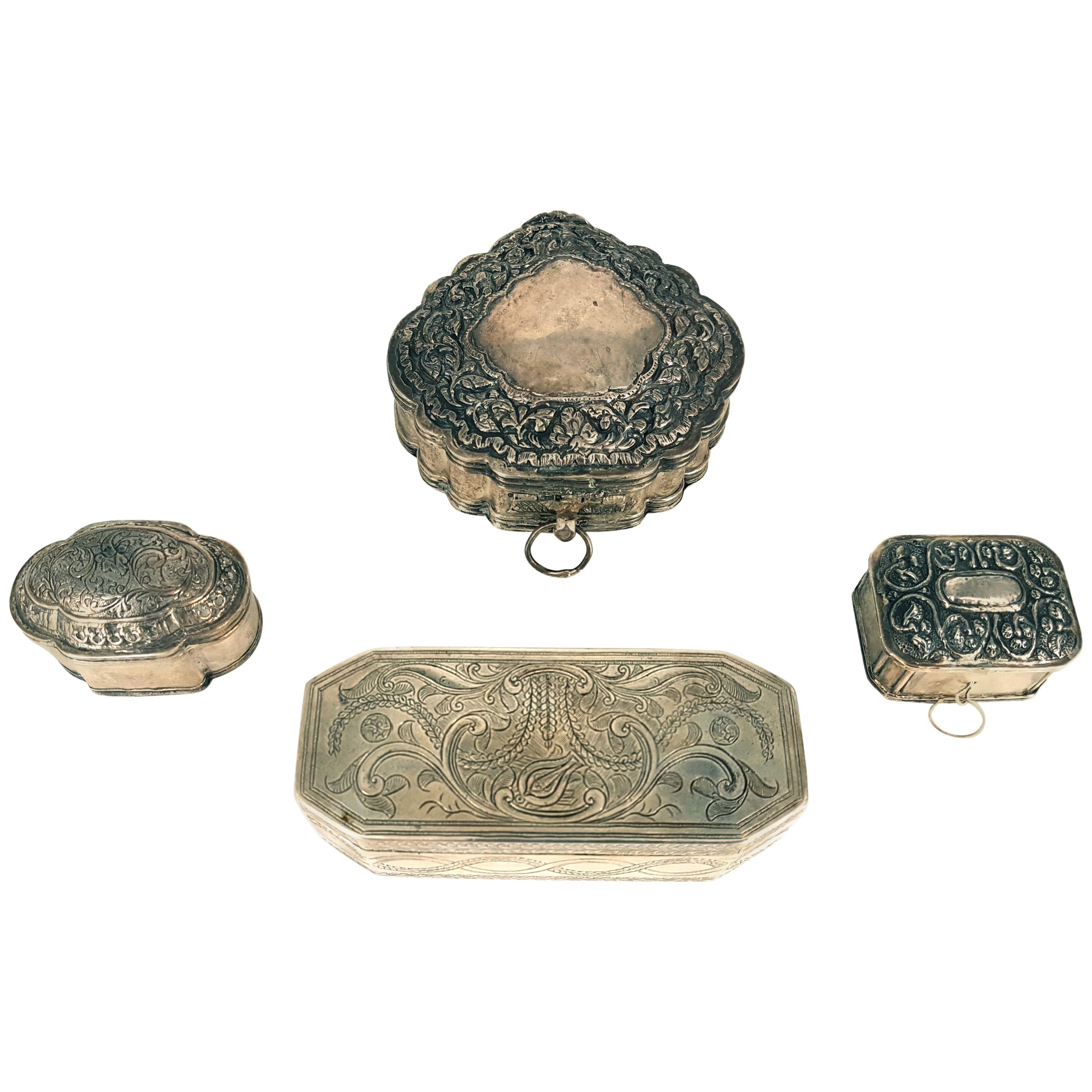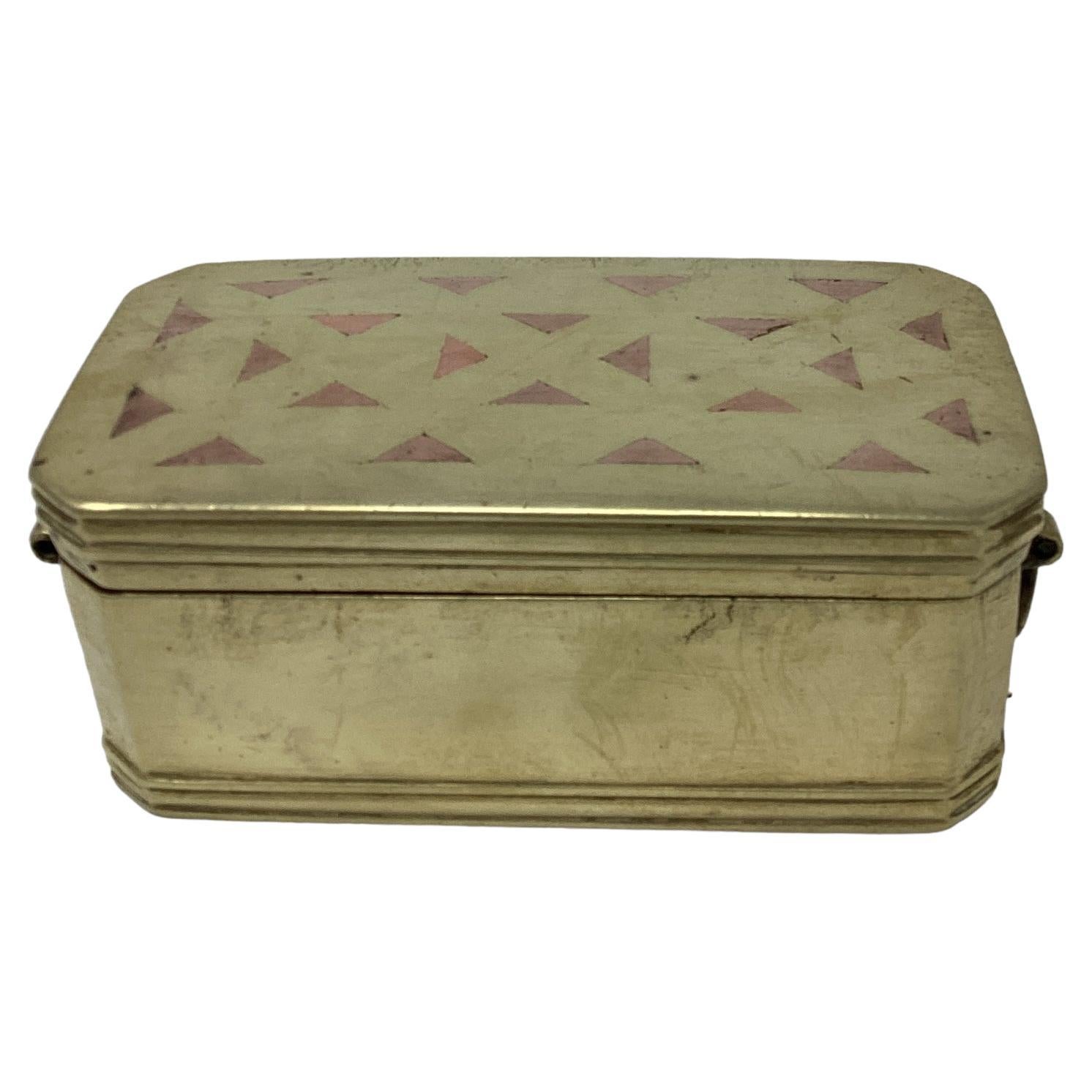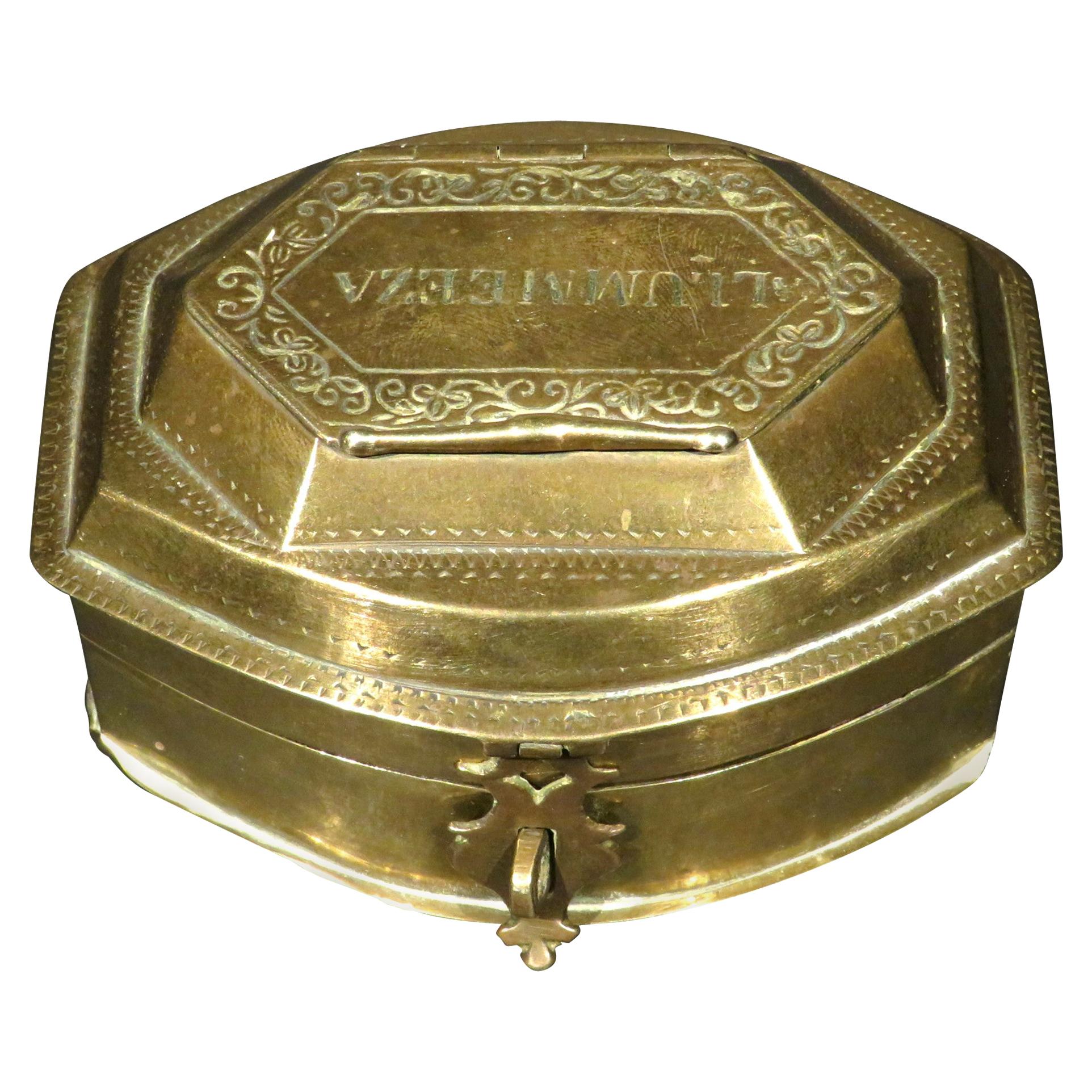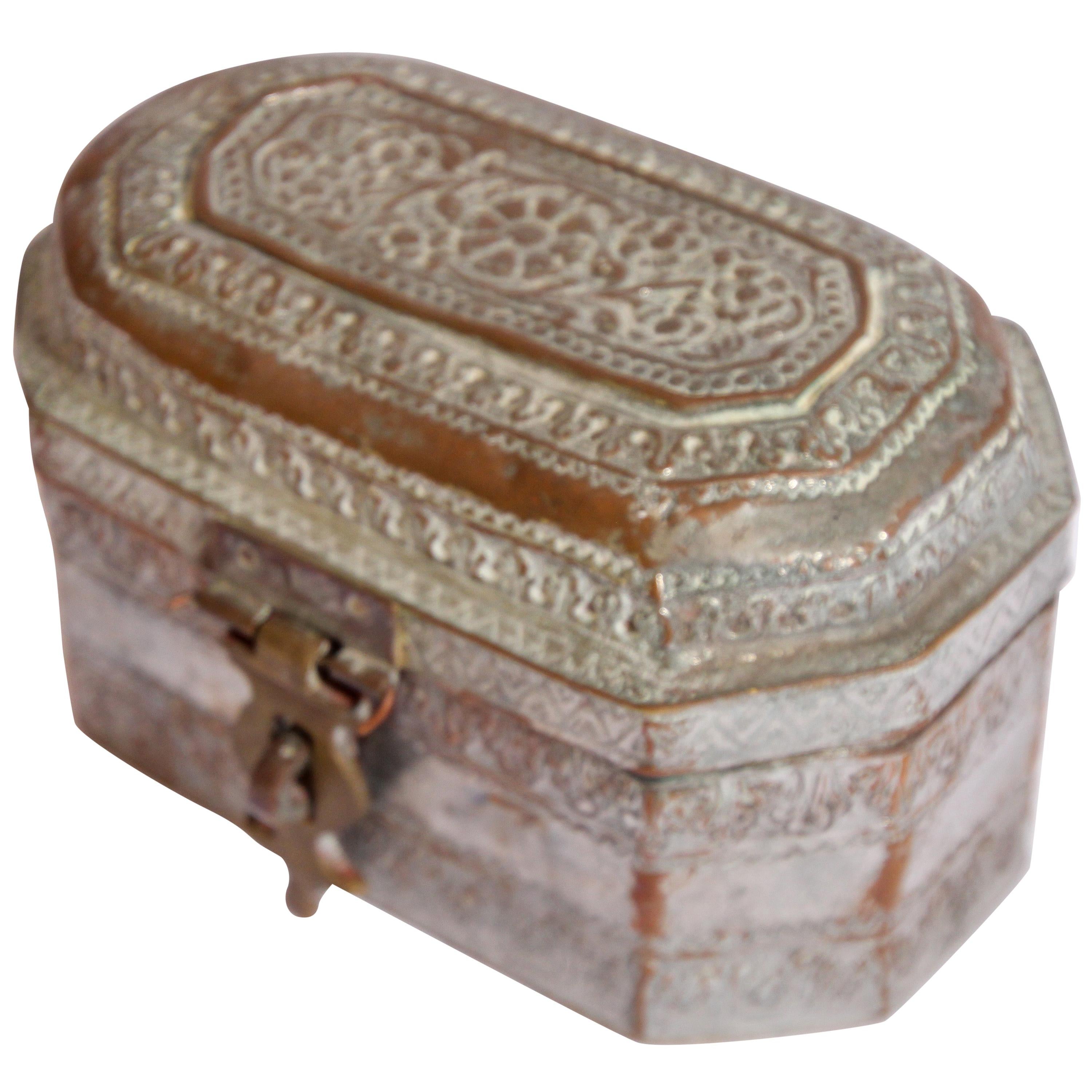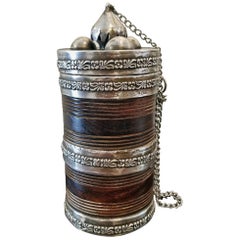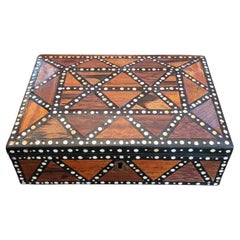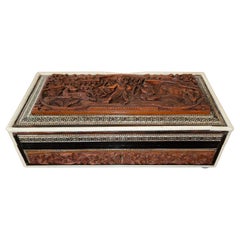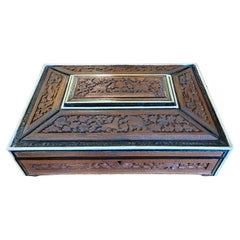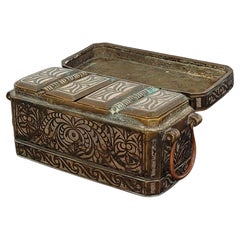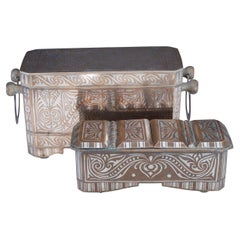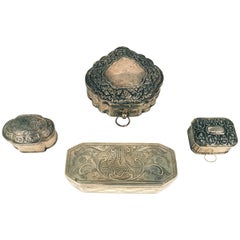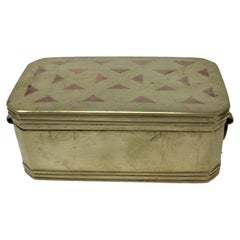Items Similar to Set of 6 Mindanao Brass Silver Betel Boxes, Philippines
Want more images or videos?
Request additional images or videos from the seller
1 of 21
Set of 6 Mindanao Brass Silver Betel Boxes, Philippines
$5,000per set
£3,771.29per set
€4,355.88per set
CA$7,005.34per set
A$7,789.54per set
CHF 4,077.97per set
MX$95,150.70per set
NOK 51,243.65per set
SEK 48,204.92per set
DKK 32,516.34per set
About the Item
Presenting an amazing set of 6 Mindanao brass silver betel boxes, Philippines.
Betel chewing was prevalent in the southern Philippines as in much of the rest of Southeast Asia. Wealthier Maranao families on Mindanao were able to afford elaborate silver-inlaid brass betel boxes such as these examples, made up of 3 large and 2 medium boxes made of brass and silver and one smaller one made of silver and copper.
Such boxes were used to show off to household visitors and from which they were offered betel and the other component such as leaves and lime to make up the betel quid.
The box comprises an outer box with a hinged lid and handles, and an inner box that is divided into three lidded compartments covered by four hinged lids. One compartment was for powdered lime which was an essential part of the betel quid. Remnants of lime remain caked to the interior.
Both the inner and outer boxes rest on coin-like ‘wheels’. The inner box is a separately made, self-contained unit decorated on all sides with silver inlay. It drops into the outer box.
Both the outer and outer boxes are decorated with silver inlay on all visible sides with a repeated stylised orchid motif within scrolling obid-obid (stylised rope) borders, and stylised tail feathers of the sari-manok bird. Designs such as these are drawn from a local design repertoire that has its origins in wood carving.
This lutuan represents a fine and large example of Islamic metalwork from the most eastern outreach of Islamic art and civilisation: Mindanao island being significantly further east than even China – artwork from Islamic Southeast Asia remains chronically under-represented in the world’s major collections of Islamic art. It is in excellent condition with no losses to the silverwork. Evidence of use remains inside the lidded chambers.
Smaller examples are illustrated in several books including Henkel et al (2009, p. 156). Lutuan tell an interesting story of the spread of Islam and Islamic crafts. The silver inlay work shown on this box originated in Syria. The function originated in India. But the craftsmen were based in the Islamic southern Philippines.
These examples are in fair to good original condition with a fine patina suggesting their age. There are some minor repairs and losses to the silverwork. All are missing their handles. Some internal lids are missing as can be seen from photos.
The larger one has lost its wheels on the left due to loss of the brass undercarriage that would have held the wheels. The right side actually has Philippine US Silver coins dated 1944 and a copper cap. These would have been added to the box in 1944 as the box would have been made circa 1890-1900.
This is a rare chance to own an immediate collection of these rare boxes !
Provenance: From a Private Dallas Collection
Condition: Fair to good original condition. Some losses and repairs as listed in the description and evident from photos.
Dimensions: Large box on wheels is 5 inches tall, 8 inches wide and 3.75 deep
Large box on left is 4 inches tall, 8 inches wide and 3.75 deep
Large box on right is 4 inches tall, 7.5 inches wide and 3.5 deep
Medium box on left is 3.25 inches tall, 6.75 inches wide and 3.2 deep
Medium box on right is 3.25 inches tall, 6.75 inches wide and 3.2 deep
Small box at the front is 2.75 inches tall, 6 inches wide and 3 deep.
- Dimensions:Height: 5 in (12.7 cm)Width: 8 in (20.32 cm)Depth: 3.75 in (9.53 cm)
- Sold As:Set of 6
- Style:Islamic (Of the Period)
- Materials and Techniques:
- Place of Origin:Philippines
- Period:
- Date of Manufacture:1890
- Condition:Replacements made: Wheels on larger one. Repaired: Some hinges repaired. Wear consistent with age and use. Minor losses. Minor structural damages. Minor fading. In fair to good original condition with a fine patina suggesting their age. There are some minor repairs and losses to the silverwork. All are missing their handles. Some internal lids are missing as can be seen from photos.
- Seller Location:Dallas, TX
- Reference Number:1stDibs: LU3978127583752
About the Seller
4.9
Vetted Professional Seller
Every seller passes strict standards for authenticity and reliability
Established in 2015
1stDibs seller since 2018
393 sales on 1stDibs
- ShippingRetrieving quote...Shipping from: Dallas, TX
- Return Policy
Authenticity Guarantee
In the unlikely event there’s an issue with an item’s authenticity, contact us within 1 year for a full refund. DetailsMoney-Back Guarantee
If your item is not as described, is damaged in transit, or does not arrive, contact us within 7 days for a full refund. Details24-Hour Cancellation
You have a 24-hour grace period in which to reconsider your purchase, with no questions asked.Vetted Professional Sellers
Our world-class sellers must adhere to strict standards for service and quality, maintaining the integrity of our listings.Price-Match Guarantee
If you find that a seller listed the same item for a lower price elsewhere, we’ll match it.Trusted Global Delivery
Our best-in-class carrier network provides specialized shipping options worldwide, including custom delivery.More From This Seller
View All19th Century Anglo-Indian Spice or Tea Caddy with Silver Mounts
Located in Dallas, TX
PRESENTING A GORGEOUS 19C Anglo Indian Rosewood Caddy with Silver Mounts.
Really nice and unusual, 19th Century Anglo-Indian Spice or Tea Caddy, from cir...
Category
Antique Late 19th Century Indian Anglo Raj Tea Caddies
Materials
Sterling Silver
19C Anglo Ceylonese Specimen Wood Trinket Box
Located in Dallas, TX
PRESENTING A BEAUTIFUL and RARE 19C Anglo Ceylonese Specimen Wood Trinket Box.
Made in ‘Galle’, Ceylon (now Sri Lanka) circa 1860-80.
Made for the ex...
Category
Antique 19th Century Sri Lankan Anglo-Indian Jewelry Boxes
Materials
Bone, Hardwood, Ebony, Sandalwood
19C Anglo Indian Carved Teak Wood and Sadeli Mosaic Box
Located in Dallas, TX
PRESENTING A LOVELY 19th century Anglo-Indian Carved Teak Wood and Sadeli Mosaic Box, featuring a carving of a Hunt Scene.
Made circa 1870 in Bombay, India during the Rule of the Br...
Category
Antique Late 19th Century Indian Anglo-Indian Jewelry Boxes
Materials
Silver, Pewter
19c Anglo Indian Highly Carved Teak and Sandalwood Sarcophagus Sewing Box
Located in Dallas, TX
PRESENTING A VERY NICE 19C Anglo Indian Highly Carved Teak and Sandalwood Sarcophagus Sewing Box.
Made in Bombay, India circa 1890-1900.
The box case/body is made of sandalwood wit...
Category
Antique Late 19th Century Indian Anglo-Indian Decorative Boxes
Materials
Bone, Sandalwood, Teak
19C Anglo Indian Vizigapatam Stamp Box
Located in Dallas, TX
Presenting an absolutely gorgeous and very rare 19C Anglo Indian Vizigapatam stamp box.
Made in Colonial India (the Time of the Raj) circa 1860.
Prob...
Category
Antique Mid-19th Century Indian Anglo-Indian Decorative Boxes
Materials
Bone, Shell
19C Anglo Indian Highly Carved Teak Sadeli Mosaic Inlaid Sewing Box
Located in Dallas, TX
PRESENTING A LOVELY 19C Anglo Indian Highly Carved Sadeli Mosaic Inlaid Sewing Box.
Made in Bombay, India, circa 1880.
The box is made of sandalwood with highly carved raised teak wood panels on all sides, depicting temple scenes, animals and foliage.
The box is in a sarcophagus form.
It is edged in bone (and we can tell it is bone and not ivory, from the color and evidence of capillaries, which are not found in ivory), and banded with Bombay Sadeli mosaic and ebony veneer.
The lid opens to reveal a removable tray with various open compartments and lidded compartments. 5 lidded compartments, 1 unlidded compartment and 8 holders for thimbles, etc
The tray lifts to reveal a blue velvet (original) lined section, for storing jewelry etc, with sections for collars etc.
The inside of the lid has a removable mirror (the mirror is missing on this one but can easily be replaced). Behind the mirror is the original green velvet lining.
It has its original brass carry handles on the sides and sits on 4 silvered button feet (of recent origin).
Some repairs to the exterior and condition issues (priced accordingly), but still a LOVELY COLLECTIBLE box!
These boxes were made by superb Indian craftsmen, specifically for sale to the ruling British elite. These types of boxes, carved padouk and sandalwood, (whilst beautiful and superbly crafted) were of a lesser quality, than the more profusely and intricately mosaic inlay, tortoiseshell and ivory boxes, made for the British ‘Upper Classes’ in the areas of Bombay and Vizagapatam. These type of boxes were much more affordable back in 1880 (and indeed today) and would probably have been bought by mid-level diplomats, civil servants or visitors.
Sewing boxes (in general), were in EVERY Victorian home in Britain in the 19th century and like other boxes etc were ‘status symbols’ of your place in society! The more ornate the box, the more ‘Upper Class’ you were!
SADELI MOSAIC: “Anglo Indian boxes were made in India for the English residents from the early part of the 18th century. They were brought back or sent back to England usually by the people who had commissioned them. From the beginning of the nineteenth century they were imported more commercially, although not in any significant numbers until the middle decades. They were very highly valued, especially the early ones, to the extent that the designs were copied on late 19th and early 20th century tins.
The ancient art of Sadeli Mosaic is said to have been introduced from Shiraz in Persia via Sind to Bombay, a long time before the Anglo Indian boxes were made. It was a technique, which required a high degree of skill and patience. It was executed very lavishly, in that the frequent cuts wasted a great amount of the precious materials used. The workmanship was however more than commensurable to the value of the materials.
Ivory, silver, pewter (or other metals), wood and Horn were cut into faceted rods which were bound together to form geometric patterns. When the glue has set, the rods were sliced in transverse sections. This gave the maker a number of angled circular pieces in the original pattern. Several variations of patterns could be achieved by combining the materials in different ways. The ivory was sometimes dyed green to give an extra color.
The mosaic pieces in a combination of patterns, often separated by ivory, ebony, Horn or silver stringing were used to veneer sandalwood boxes. In the early boxes, which date from the turn of the 18th to the 19th century, there are large panels of mosaic covering tops and sides of boxes. It took incredible skill to cover such large areas without any shakes or wavering of the pattern. The corners and joins on these boxes are impeccably matched.
The makers (reputed to be Persian) of Sadeli mosaic made in the first two decades of the 19th century displayed a total understanding of the qualities of the different materials they used. They combined substances, which can expand and contract according to atmospheric conditions with others, which are hard and unyielding. The result was a sharp definition of the lines and patterns, which made up the whole design.
On the early boxes the designs look deceptively simple. The fact is, they emerged from a culture, which had mastered geometry and understood how to generate a pattern from a set number of points. The patterns are so harmoniously combined that their incredible complexity is not immediately apparent.
The earliest Sadeli boxes...
Category
Antique Late 19th Century Indian Anglo-Indian Decorative Boxes
Materials
Bone, Sandalwood, Teak
You May Also Like
Antique Southeast Asian Filipino Maranao Silver Inlaid Brass Betel Nut Box
Located in Forney, TX
A scarce fine quality antique silver-inlaid solid brass betel nut box (Lutuan), dating to the second half of the 19th / early 20th century, hand-crafted in Mindanao, Philippines.
Boxes such as this were used to store the areca nut (also known as the betel nut) which would be wrapped in a betel leaf with lime paste and other ingredients, often tobacco, for chewing. Similar to the European tea caddy, these boxes often served as a way to impress while showing off ones wealth.
Betel chewing was prevalent in the southern Philippines as in much of the rest of Southeast Asia. Wealthier Maranao families on Mindanao were able to afford elaborate silver-inlaid brass betel boxes such as this example. Such boxes were used to show off to guests and from which they were offered betel and the other component such as leaves and lime to make up the betel quid.
Rare large size, most extant examples of such boxes tend to measure around 5 inches in length. At slightly more than 7.75 inches the example here is larger than most.
The distinctive decorative box features a very heavy strong-box like rectangular shaped chest form with canted corners, copper handles, and a conforming hinged lid, lifting open to reveal an interior divided into three compartments covered by four hinged lids. Each of these doors is inlaid with silver in stylized orchid flower patterns.
Exceptionally executed throughout, the arabesque silver inlaid exterior is decorated to the top with a large orchid motif within scrolling obid-obid (stylized rope) borders. The front, back and sides are inlaid with sets of stylized tail feathers of the sari-manok bird beneath which are unusual, highly stylized whimsical zoomorphic faces that appear like cat or tiger faces. (Such stylisation is accounted for by Southeast Asian Islamic preferences to avoid the overt and this potentially idolatrous representation of animal and human forms. Designs such as these are drawn from a local design repertoire that has its origins in wood carving.
Although the spread of Islam in the Philippines began in the 14th century, mostly through the influence of Muslim merchants from the western Malay Archipelago, decorative arts in this design remain exceptionally rare. This lutuan represents a fine example of Islamic metalwork from the most eastern outreach of Islamic art and civilisation: Mindanao island being significantly further east than even China – artwork from Islamic Southeast Asia remains chronically under-represented in the world’s major collections of Islamic art.
PROVENANCE / ACQUISITION
Acquired from highly reputable auction house, Austin Auction Gallery, established 1983, Austin, Texas.
References
Brownrigg, H., Betel Cutters...
Category
Antique 19th Century Philippine Islamic Decorative Boxes
Materials
Silver, Brass, Bronze, Copper
Deluxe Betel Nut Box Set, Maranao Culture, Southern Philippines (Mindanao).
Located in Point Richmond, CA
Two bronze rectangular boxes decorated with symmetrical silver inlay in the tendril vine pattern referred to as “the okir pattern”, a traditional design for the Maranao people. This...
Category
Early 20th Century Philippine Tribal Metalwork
Materials
Silver, Bronze
Four Vessels with Indonesian Lids in Silver
Located in Roma, IT
There are four vessels with Indonesian lids in silver.
Dimensions:
1, Height 3.5 cm, width 10.5 cm, length 4.5 cm
2, Height 4 cm, diameter 10 cm
3, Height 4 cm, diameter 6 cm
...
Category
20th Century Indonesian Modern Decorative Boxes
Materials
Silver
Antique Brass and Copper inlaid Betel Nut Box
Located in Chapel Hill, NC
Antique Philippine Brass and Copper inlaid Betel Nut Box. The top lifts to reveal 2 hinged compartments that held the betel leaf, areca nut. Top is ...
Category
Antique 1870s Decorative Boxes
Materials
Brass, Copper
An Early 20th Century Brass Betel Box or Pandan, Probably Brunei Circa 1900
Located in Ottawa, Ontario
The brass body showing a hinged lid rising up to a faceted receptacle with an engraved hinged cover, overtop a hinged open compartment which then lifts to reveal an interior fitted ...
Category
Early 20th Century Bruneian Other Snuff Boxes and Tobacco Boxes
Materials
Brass
Handcrafted Tinned Copper Metal Betel or Spices Caddy Box
Located in North Hollywood, CA
Beautiful handcrafted tinned copper decorative octagonal betel box with lid and brass latch.
The metal is delicately and intricately hand-hammered and repousse with floral and geometric designs.
This Vintage brass box...
Category
Early 20th Century Indian Anglo-Indian Decorative Boxes
Materials
Brass
More Ways To Browse
Filipino Furniture
Filipino Art
Filipino Wood
India Silver Brass
Made In Philippines
Silver Box India
Coin Box
Small Asian Box
Islamic Brass
Asian Handled Box
Philippines Antique
Tea Set Wood Handle
Antique Brass Wheels
Copper Islamic
Copper And Silver Inlay
Silver On Copper Tea Set
Asian Brass Wood Box
Philippines Carving
